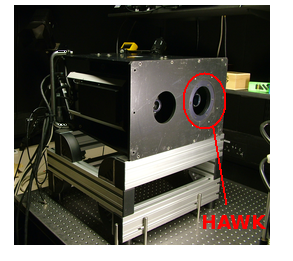| Version 4 (modified by mark1, 13 years ago) (diff) |
|---|
Hawk Hyperspectral Sensor
The Hawk sensor is a short wave infra-red hyperspectral instrument manufactured by Specim. It operates as a separate instrument, but complimentary with, the Eagle hyperspectral instrument.
Raw data format
The Hawk data is captured as ENVI format BIL files (a pair of .hdr and .raw), with an associated nav file per line. The .hdr files are ASCII text files where as the .raw and .nav are binary data files.
The Hawk .raw data files contain 14-bit data (values of 0-16383) stored as 16-bit integer. The first pixel of the first band of each raw file is the frame counter pixel, which is essentially a frame id tag that increments by 1 through out the file. At the end of the raw file, after data capture for this flight line, a number of lines of data are captured with the shutter closed. These lines are referred to as "dark lines" and give sensor ccd values for when no light is present.
The .nav files are a collection of different 'messages'. These contain the real-time position and attitude of the aircraft as well as periodic time stamps marking the start of the flight line capture.
Timing
The Eagle instrument is connected to a nav-sync box that timestamps the start of acquisition against GPS time. This measures the time to the next GPS pulse-per-second, from the first start of integration pulse from the camera that occurs after the start of acquisition pulse from the recording system.
The frame grabber lag time is unknown. Previously it was thought to be 55ms regardless of frame rate (i.e. a frame is captured 55ms before the nav sync pulse), but this was actually a once-off correction applied by Specim for a single dataset. What was called the frame grabber lag time is actually an unknown timing error in the system. Further work is underway to isolate this.
Consequently the timing of a start of acquisition is next_GPS_PPS - navsync_time - <unknown and variable error>ms.
Specifications for Hawk SN300011 - Operated in period 2006 - 2012
| Detector size | 320x256 | |
| Bit depth (of sensor analog to digital converter) | 14 bit | |
| Spatial pixels | 320 (unbinned) | |
| Spectral pixels | 256 typically ~220 in use | |
| Spectral resolution | 12 nm | |
| Nominal spectral range (prior to calibration) | 970-2500nm | |
| Central pixel number | 160 (unconfirmed) | |
| Focal length | 22.8mm (manufacturer supplied) (22.5mm on manufacturer datasheet retrieved 20090817 - http://www.specim.fi/products/aisa-airborne-hyperspectral-systems/aisa-series.html | |
| Field of View (FOV) | 24.0 degrees (from manufacturer datasheet retrieved 20090817 - http://www.specim.fi/products/aisa-airborne-hyperspectral-systems/aisa-series.html | |
| Pixel size | 30 micrometers (unbinned) | |
| IFOV | 0.075 degrees (from manufacturer datasheet retrieved 20090817 - http://www.specim.fi/products/aisa-airborne-hyperspectral-systems/aisa-series.html |
The smile and keystone are <5 microns, according to the datasheet.
Note that the field of view and focal length parameters are not measured but are quoted from specifications or mathematically calculated by the manufacturer, so there will be some error.
Specifications for Hawk SN310018 - Operated in period 2013 - onwards
| Detector size | 320x256 |
| Bit depth (of sensor analog to digital converter) | 14 bit |
| Spatial pixels | 320 (unbinned) |
| Spectral pixels | 256 typically ~220 in use |
| Spectral resolution | 12 nm |
| Nominal spectral range (prior to calibration) | 970-2500nm |
| Central pixel number | 160 (unconfirmed) |
| Focal length | 14.958 (from manufacturer calibration report received 2013) |
| Field of View (FOV) | 35.48 degrees (from manufacturer calibration report received 2013) |
| Pixel size | 30 micrometers (unbinned) |
| IFOV | 0.111 degrees (from manufacturer calibration report received 2013) |
The max keystone is 0.19 pixels (from manufacturer calibration report received 2013)
Bad pixels
Jukka @ Specim sent email (25/July/2008) detailing some properties of the Hawk sensor. A summary is:
- the detector is a mercury cadmium telluride (MCT) sensor
- this is sealed in a vacuum, which may gradually leak and increasingly cause more bad pixels to appear
- the leaking process takes 6 months to several years according to the manufacturer, and the sensor can be restored by a factory process (at Specim?)
- if we see an increase in bad pixels, we may wish to have the instrument serviced, but recalibrations will save some of the pixels anyway
- bad pixel specification: "if the pixel peak responsivity differs more than +/- 30% from average responsivity, it is considered to be bad. According to specification less than 2% of pixels should be bad. In practice that is from 0.3 to 1.0 %."
Attachments (1)
- hawk.png (145.4 KB) - added by emca 14 years ago.
Download all attachments as: .zip
